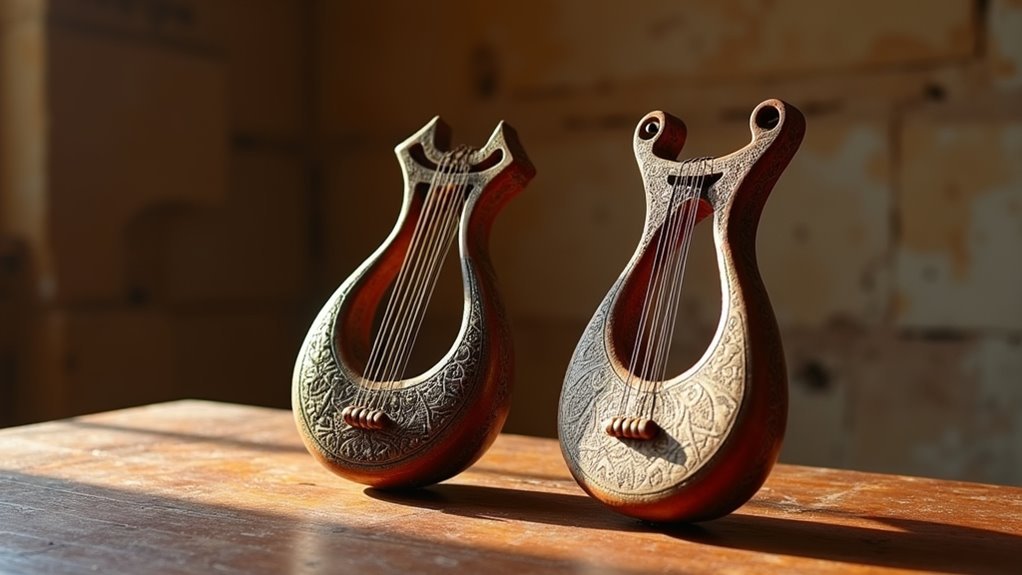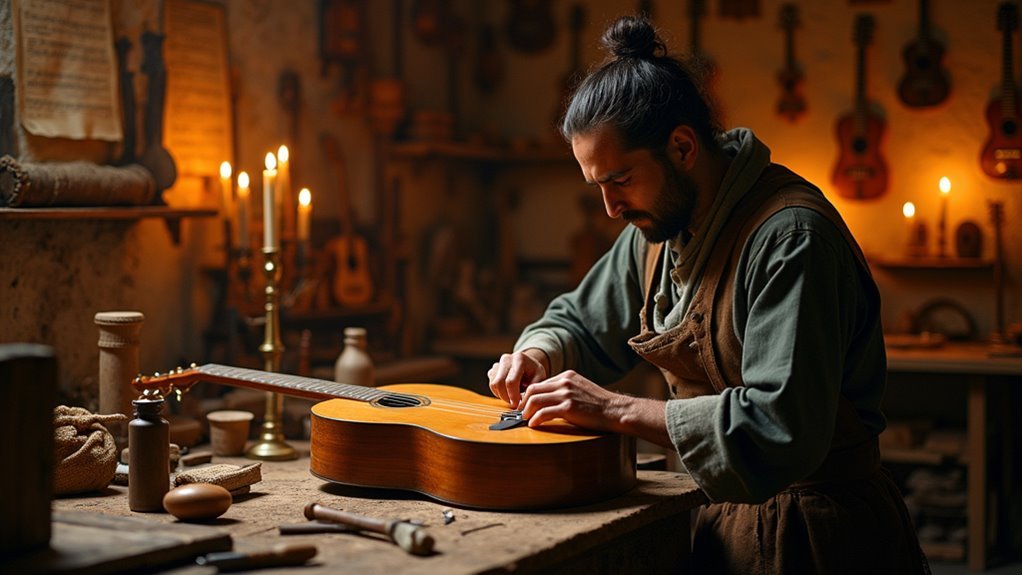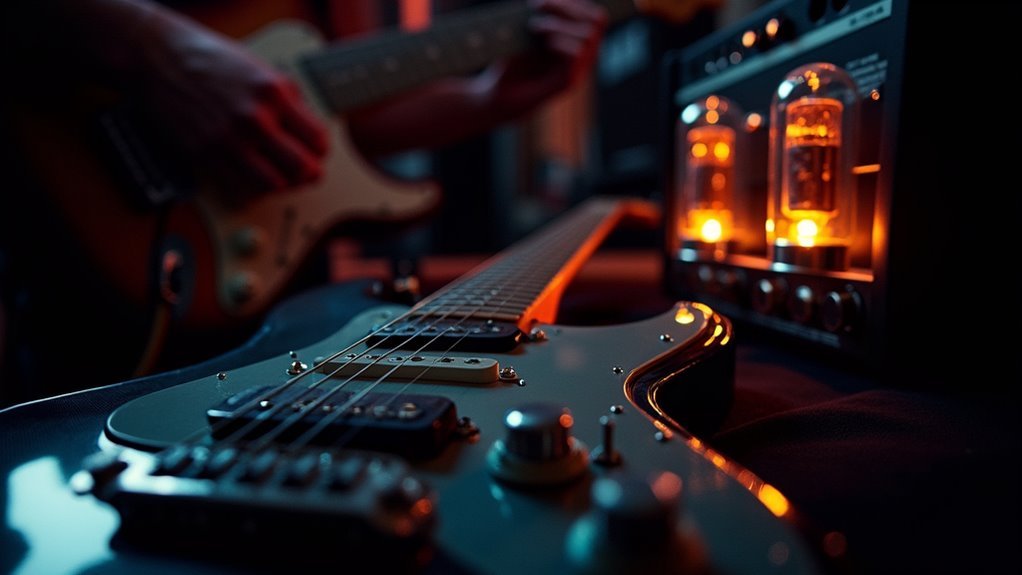We’re about to take an eye-opening journey through the guitar’s epic transformation – from ancient Egyptian courts to modern digital studios. Every curve, string, and fret of today’s guitar tells a story spanning millennia. Let’s trace how this humble stringed instrument evolved from primitive lyres and tanburs into the versatile powerhouse that’s shaped countless genres of music. The tale begins in civilizations long gone, but its impact echoes in every chord we strike today.
Ancient Roots: From Egyptian Tanbur to Mesopotamian Lyre

Within the dusty ruins of ancient Mesopotamia and Egypt, we find the earliest ancestors of today’s guitar.
Let’s trace these stringed instruments back to their origins around 3000 BCE, where the lyre dominated Mesopotamian musical culture. We’re talking real ancient civilizations here – Egyptian artifacts show us the tanbur, complete with a sound box that’d make any modern guitarist nod in recognition.
But here’s where it gets interesting: The oud, that pear-shaped wonder from the Middle East, changed everything.
When the Moors brought it to Spain during the Middle Ages, it evolved into the lute – and that’s when things really took off. That rounded back and fretted neck? They’re the DNA of modern guitars, linking those ancient instruments to the six-string beauties we play today.
The Moorish Legacy: How the Oud Shaped Guitar Development
One instrument revolutionized the evolution of the guitar like no other – the oud.
When the Moors brought this rounded-back, fretless beauty to Spain, they unknowingly sparked a musical revolution that would shape stringed instruments for centuries.
Let’s be clear: we wouldn’t have today’s guitar without the oud’s influence. Its distinctive body shape and playing style directly inspired the guitarra española, the classical guitar‘s immediate ancestor.
As this Middle Eastern marvel spread across Europe, regional variations emerged, each contributing to the guitar’s development.
The oud’s legacy lives in every guitar we play. From its construction to its sound characteristics, we’re still using design elements that trace back to those Moorish innovators.
It’s the missing link between ancient instruments and our modern six-string companions.
Spanish Renaissance and the Birth of Classical Guitar

After the oud transformed Spanish music, the Renaissance ushered in a game-changing development: the vihuela.
Let’s explore how this six double-stringed marvel revolutionized guitar history and set the stage for today’s classical guitar.
Here’s what made the Spanish Renaissance period essential for guitar evolution:
- The vihuela dominated Spanish aristocracy’s musical scene, featuring a flat back and fretted fingerboard that would define future guitars.
- The guitarra española emerged in the 16th century, introducing the rounded back we recognize today.
- The Baroque period added a fifth course and standardized tuning, expanding the instrument’s versatility.
- Antonio de Torres Jurado’s 19th-century innovations – larger bodies and strategic bracing – created unprecedented tonal quality and projection.
We’re looking at a transformation that turned a courtly instrument into the powerhouse classical guitar we cherish today.
The Steel-String Revolution: A New Era of Sound
When steel strings revolutionized guitar design in the early 20th century, we witnessed the birth of an entirely new sonic landscape.
Thanks to advancements in metal technology, we got brighter tones and more volume than ever before. C.F. Martin’s game-changing X-bracing system made it all possible, giving guitars the structural support they desperately needed.
Martin’s X-bracing system revolutionized guitar design, allowing steel strings to deliver unprecedented volume and brilliance without compromising structural integrity.
Let’s be clear: the steel-string guitar’s larger body size and enhanced tonal projection changed everything. Its superior playability across musical genres – from folk to jazz – made it unstoppable.
The acoustic sound was perfect for vocals, and those brilliant, powerful strings dominated the folk revival. We’re talking about an innovation that didn’t just stop there – it sparked the development of electric guitars, forever transforming how we experience music.
Electric Innovation: Amplifying the Guitar’s Voice

The electric guitar’s emergence in the 1930s didn’t just amplify sound – it completely redefined what a guitar could be. The introduction of amplification technology solved feedback issues plaguing hollow-body guitars, while Les Paul’s solid-body electric guitar design revolutionized music forever.
Let’s explore why this innovation changed everything:
- Amplification technology enabled unprecedented volume levels and sustained notes.
- Pickup variations (single-coil and humbucker) expanded tonal versatility.
- Iconic brands like Fender and Gibson created legendary models that shaped rock music.
- Integration with effects pedals opened new sonic possibilities.
From the Stratocaster to the Les Paul, these instruments transformed contemporary music.
We’re still witnessing their impact as digital processing pushes boundaries, proving the electric guitar’s enduring influence on musical innovation.
Digital Age Transformations: Modern Guitar Technology
Modern guitar technology has radically transformed how we create, record, and experience music.
We’re seeing hybrid digital guitars that merge traditional craftsmanship with programmable features, releasing unprecedented creativity and performance versatility.
Today’s innovations in pickup systems brilliantly capture acoustic resonance while enabling seamless amplification.
Modern pickup technology creates a perfect marriage between natural acoustic warmth and pristine electric amplification, revolutionizing guitar sound capture.
Digital modeling technology lets us access virtual amps and effects – goodbye, bulky gear!
We’re exploring infinite sound textures and musical expression through these advances.
Modern guitars are built smarter, too.
Advanced materials like carbon fiber laugh at environmental challenges while maintaining pristine tone.
It’s a brave new world where our instruments sync wirelessly, shape-shift tonally, and deliver studio-grade sound anywhere.
We’re not just playing guitars anymore – we’re commanding musical workstations that happen to have strings.
Frequently Asked Questions
What Is the History of the Guitar Its Origins and Evolution?
We’ve seen guitar innovations evolve from ancient stringed instruments through cultural influences, leading to acoustic and electric designs, with famous guitarists shaping performance techniques across genres throughout history’s musical journey.
What Is the Origin for Guitar?
Ever wonder about guitar’s ancient roots? We can trace stringed instruments back to Mesopotamia around 3000 BCE, where musical traditions and instrument construction evolved through various regional variations to create today’s modern guitar.
What Is the Early Ancestor of the Guitar?
We can trace the guitar’s early ancestors to ancient stringed instruments like the lyre from Mesopotamia and the oud from the Middle East, which influenced lute development and music evolution.
Which Two Instruments Played the Biggest Role in the Evolution of Our Modern Day Guitar?
We can trace our modern guitar’s development primarily to the oud and vihuela, which merged cultural significance and instrument craftsmanship to establish the fundamental acoustic design and classical influence we recognize today.